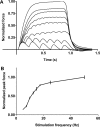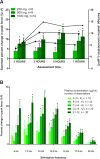Tirasemtiv amplifies skeletal muscle response to nerve activation in humans
- PMID: 24634285
- PMCID: PMC4260123
- DOI: 10.1002/mus.24239
Tirasemtiv amplifies skeletal muscle response to nerve activation in humans
Abstract
Introduction: In this study we tested the hypothesis that tirasemtiv, a selective fast skeletal muscle troponin activator that sensitizes the sarcomere to calcium, could amplify the response of muscle to neuromuscular input in humans.
Methods: Healthy men received tirasemtiv and placebo in a randomized, double-blind, 4-period, crossover design. The deep fibular nerve was stimulated transcutaneously to activate the tibialis anterior muscle and produce dorsiflexion of the foot. The force-frequency relationship of tibialis anterior dorsiflexion was assessed after dosing.
Results: Tirasemtiv increased force produced by the tibialis anterior in a dose-, concentration-, and frequency-dependent manner with the largest increases [up to 24.5% (SE 3.1), P < 0.0001] produced at subtetanic nerve stimulation frequencies (10 Hz).
Conclusions: The data confirm that tirasemtiv amplifies the response of skeletal muscle to nerve input in humans. This outcome provides support for further studies of tirasemtiv as a potential therapy in conditions marked by diminished neuromuscular input.
Keywords: Phase 1; fast skeletal muscle troponin activator; force-frequency relationship; skeletal muscle; tirasemtiv.
© 2014 The Authors. Muscle Nerve published by Wiley Periodicals, Inc.
Figures


References
-
- Sharma KR, Miller RG. Electrical and mechanical properties of skeletal muscle underlying increased fatigue in patients with amyotrophic lateral sclerosis. Muscle Nerve. 1996;19:1391–1400. - PubMed
-
- Kent-Braun JA, Miller RG. Central fatigue during isometric exercise in amyotrophic lateral sclerosis. Muscle Nerve. 2000;23:909–914. - PubMed
-
- Monani UR. Spinal muscular atrophy: a deficiency in a ubiquitous protein; a motor neuron-specific disease. Neuron. 2005;48:885–896. - PubMed
-
- Drachman DB. Myasthenia gravis. N Engl J Med. 1994;330:1797–1810. - PubMed
Publication types
MeSH terms
Substances
LinkOut - more resources
Full Text Sources
Other Literature Sources

